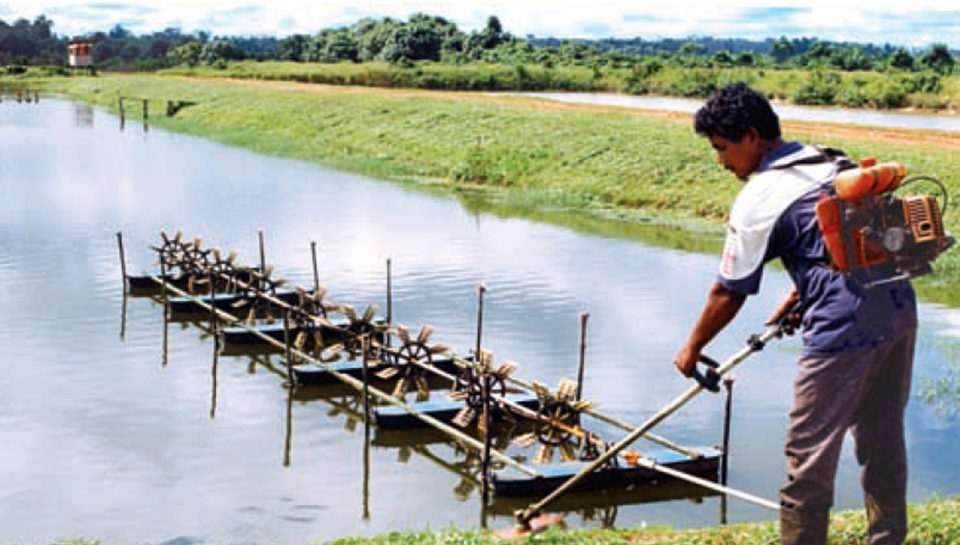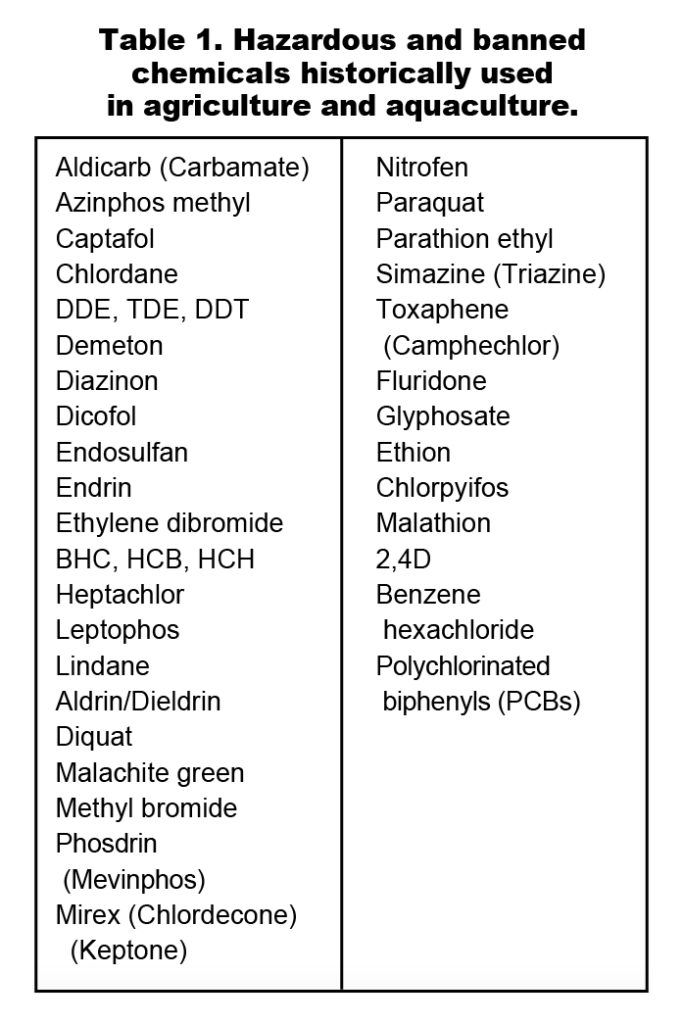Control pests, vegetation with limited application of approved products

As the aquaculture industry has expanded, many aquaculturists have adopted chemicals used in the agriculture sector to treat pests, control algae and unwanted vegetation, and enhance growth and production. When properly applied, pesticides, algaecides, herbicides, and fungicides are indeed beneficial in controlling pests and noxious vegetation. However, their improper use and runoff from agriculture can affect water and sediment quality, alter microbial communities and biodiversity, kill nontarget animals and plants, and affect the health of farm workers.
Environmental concerns often focus on the presence of persistent pesticides with long half-lives in sediments, the effects of biocidal properties on aquatic life, and the accumulation of hazardous pesticides in body tissues, which presents food safety problems. The toxicity of any chemical in aquaculture is difficult to predict, since it is influenced by water quality, temperature, pH, dissolved oxygen, alkalinity, turbidity, and animal health.
Chemical types

Chemicals can be grouped by categories and classified as to their toxicological effects on aquatic life, animals, and humans; and ecological effects on the environment. Those considered highly toxic are normally referred to as category 1 chemicals, while category 2 is used to describe chemicals that are moderately or slightly toxic to humans.
Category 1 chemicals are banned from aquaculture use because they pose a threat to human health or the environment, or are not recommended because they are not registered or present risks to workers, animals, or the environment. The use of approved category 2 chemicals is not recommended except under controlled use when other options have been exhausted. Some of the more hazardous banned chemicals are listed in Table 1.
Responsible use
Some recommendations for responsible chemical use in the aquaculture industry include:
- Use chemicals only when all other responsible practices have failed to solve the problem.
- Purchase only approved chemicals registered for the intended use. Do not use banned or category 1 chemicals for aquaculture purposes.
- Select properly labeled chemicals, where all ingredients are shown, based on efficacy data and available information regarding environmental persistence and potential effects on nontarget organisms. Be aware of the potential risks of the chemical selected.
- Follow the instructions on the label regarding proper dose, withdrawal period, storage and handling, disposal, and expiration date.
- Be certain workers are properly attired and trained in the application of the chemical and know the risks involved.
- Reduce the risk of potential runoff or pesticide drift to insure it does not enter the nontarget environment.
- Keep accurate records on chemical applications that include date and amount used, method of application, species treated, date product harvested, and testing results.
- Test water, soil, and product periodically for chemical residues.
Resources on chemical use
A variety of online and other sources provide information on chemical use in the aquaculture industry. Following are several useful resources on chemical use.
- Use of Chemicals in Aquaculture in Asia – Proceedings of the Meeting on the Use of Chemicals in Aquaculture in Asia, May 20-22, 1996
Lloilo Tigbauan, J. R. Arthur, C. R. Lavilla-Pitogo, and R. P. Subasinghe, editors - Fish and Agricultural Chemicals: Safeguarding Your Pond
University Extension – University of Missouri
http://muextension.missouri.edu/xplor/agguides/agengin/g01912.htm - Guide to Drug, Vaccine, and Pesticide Use in Aquaculture Texas Agriculture Extension Service – Texas A & M University System Publication No. B5085, June 1994 http://aquanic.org/publicat/govagen/usda/gdvp.htm
- Pan Pesticides Database – Pesticide Registration Status
http://pesticideinfo.org - Pan Pesticides Database – Chemicals (search engine)
http://pesticideinfo.org/search_Chemicals.jsp - EXTONET – The Extension Toxicology Network (search engine) http://extoxnet.orst.edu/ghindex.html.
(Editor’s Note: This article was originally published in the September/October 2007 print edition of the Global Aquaculture Advocate.)
Now that you've finished reading the article ...
… we hope you’ll consider supporting our mission to document the evolution of the global aquaculture industry and share our vast network of contributors’ expansive knowledge every week.
By becoming a Global Seafood Alliance member, you’re ensuring that all of the pre-competitive work we do through member benefits, resources and events can continue. Individual membership costs just $50 a year. GSA individual and corporate members receive complimentary access to a series of GOAL virtual events beginning in April. Join now.
Not a GSA member? Join us.
Author
-

William R. More
Vice President and Director
Aquaculture Certification Council, Inc.
12815 72nd Avenue Northeast
Kirkland, Washington 98034 USA
Tagged With
Related Posts

Health & Welfare
A case for better shrimp nutrition
Shrimp farm performance can often be below realistic production standards. Use proven nutrition, feeds and feeding techniques to improve profitability.

Responsibility
A look at integrated multi-trophic aquaculture
In integrated multi-trophic aquaculture, farmers combine the cultivation of fed species such as finfish or shrimp with extractive seaweeds, aquatic plants and shellfish and other invertebrates that recapture organic and inorganic particulate nutrients for their growth.

Responsibility
A look at various intensive shrimp farming systems in Asia
The impact of diseases led some Asian shrimp farming countries to develop biofloc and recirculation aquaculture system (RAS) production technologies. Treating incoming water for culture operations and wastewater treatment are biosecurity measures for disease prevention and control.

Innovation & Investment
The lasting legacy of Bill and Betty More
The husband-and-wife team of Bill and Betty More has earned admiration and respect in many parts of the world for their many decades of work in aquaculture and sustainability certification. SIRF has established a living memorial in their name.

